英语基础知识框架
英语入门基础知识集锦

英语入门基础知识集锦初级篇目录1、英语字母2、英语音标3、基础词法4、基础时态与语态5、基础句式6、基础短语7、基础造句8、基础写作9、基础阅读高级篇目录1、词法2、句式3、倒装4、主谓一致5、定语从句6、名词性从句7、状语从句8、动词不定式9、动名词10、分词11、独立主格12、虚拟语气13、重点短语搭配14、造句15、写作16、阅读初级篇一、英语字母英语字母共有26 个。
在具体书写的时候分为大写和小写两种格式。
1、26个英文字母的大小写与顺序(印刷体):大写顺序: A、B、C、D、E、F、G、H、I、J、K、L、M、N、O、P、Q、R S、T、U、V、W、X、Y、Z;小写顺序: a、b、c、d、e、f、g、h、i、j、k、l、m、n、o、p、q、r、s、t、u、v、w、x、y、z;2、26个英文字母的大小写与顺序(手写体):说明:从上表可以看出来,所有大写字母都占据了上面两格,而小写字母中只有f占据了三个格子,g,j,p,q,y 占据了下两格。
英文字母书写顺口溜:字母书写有规则,倾斜5度正适合,大写总在上两格,高低一致不会错。
小写字母也不难,请你记住这几点有头就用上两格,b d h i k l 和t有尾就占下两格,g p q y 要记着:无头无尾写中格,多练几遍就不错,剩下j f 不一般,三个格子全部占。
3、英语26个字母的读音:注解:如果一个单词,处于句子的开头位置,那最前面的字母需要大写人名、地名、国名、城市名、某些专有名词,开头的字母需要大写两个单词之间,在书写的时候,必须有一个字母的空隙隔开4、英语字母书写时的下笔顺序:二、英语音标音标知识英语字母共有26个,其中a 、e 、i、o、u是元音字母,其余的是辅音字母。
一般来说,元音字母发元音,辅音字母发辅音。
音标是对英语单词的发音的标注,告诉我们怎么读。
英语音标共有48个。
其中元音20个,辅音28个。
他们是:单元音:[i:] [i] [e] [æ] [a:] [ʌ] [ə:] [ə] [ɔ:] [ɔ] [u:] [u]双元音:[ai] [ei] [au] [əu] [ɔi] [iə] [ɛə] [uə] ɛ´'辅音:[b] [p] [d] [t] [g] [k] [v] [f] [h] [l] [m] [n] [ŋ] [s] [z] [θ] [ð] [ʃ] [ʒ] [j] [r][w] [ʧ] [ʤ] [tr] [dr] [ts] [dz]元音:发音时气流通过口腔不受任何阻碍,而且声带振动(发出声音)。
英语的语法基础知识

英语的语法基础知识英语语法基础知识包括一系列规则和结构,用于正确组织和理解英语句子。
以下是一些基本的英语语法概念:句子结构:主语和谓语:句子通常由主语(执行动作或被描述的实体)和谓语(动作或状态的核心)构成。
宾语:表示动作影响的对象。
词性(Parts of Speech):名词(Noun):表示人、事物、地点或概念。
动词(Verb):表示动作、状态或存在。
形容词(Adjective):描述名词或代词。
副词(Adverb):修饰动词、形容词或其他副词,表示方式、时间、地点等。
代词(Pronoun):替代名词的词语,如he、she、it等。
时态和语态:时态(Tense):表示动作发生的时间,包括过去、现在和将来时态。
语态(V oice):表示动作的执行者和承受者,包括主动语态和被动语态。
句子类型:陈述句(Declarative Sentence):陈述事实或观点。
疑问句(Interrogative Sentence):提问。
感叹句(Exclamatory Sentence):表示强烈情感。
从句和短语:定语从句(Relative Clause):描述名词的从句。
副词从句(Adverbial Clause):描述动词、形容词或副词的从句。
前置词和介词短语:前置词(Preposition):表示位置、方向、关系等的词语,如in、on、under 等。
介词短语(Prepositional Phrase):由前置词和其它词组成,描述名词或动词。
连词(Conjunction):并列连词(Coordinating Conjunction):用于连接同等重要的词组或句子,如and、but、or等。
从属连词(Subordinating Conjunction):引导从句,如because、although等。
这些是英语语法的一些基础概念,理解这些概念有助于构建准确、清晰的英语句子。
英语基础知识梳理

1. They are woman workers. 名词 代词
2. His father didn't write home until yesterday.
3. Mary is a beautiful girl. 形容词 adj
4. The play has three acts. 数词
5. This is her first trip to Europe. 形容词 /序数词 /to do 不定式
(三)宾语 表示动作的对象,是动作的承受者。 宾语一般放在__动_词_/_动_词_短_语___之后。__介_词__词后也 会跟宾语。
1. She covered her face with her hands. 名词 n
2. We haven't seen her for a long time. 代词 pron
词性的分类
词类又叫词性,英语单词根据其在句子中的功用,可以分十
个大类。
1 名词n. student 学生 2 代词pron. you 你 3 形容词adj. happy 高兴的 4 副词 adv. quickly 迅速地 5 动词 v. cut 砍、割 6 数词 num. three 三 7 冠词 art. a 一个 8 介词 prep. at 在... 9 连词 conj. and 和 10 感叹词interj. oh 哦
6. an excited student
过去分词 v-ed
7. I have nothing to eat. to do 不定式
8. Those who want to go to Tibet are to sign their names here. 从句
9. a swimming pool
英语语法基础知识(适用于初高中衔接)1
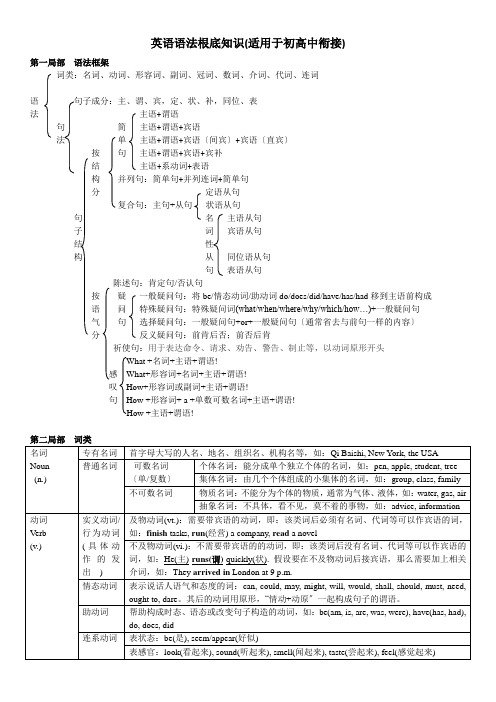
英语语法根底知识(适用于初高中衔接)第一局部语法框架词类:名词、动词、形容词、副词、冠词、数词、介词、代词、连词语句子成分:主、谓、宾,定、状、补,同位、表法主语+谓语句简主语+谓语+宾语法单主语+谓语+宾语〔间宾〕+宾语〔直宾〕按句主语+谓语+宾语+宾补结主语+系动词+表语构并列句:简单句+并列连词+简单句分定语从句复合句:主句+从句状语从句句名主语从句子词宾语从句结性构从同位语从句句表语从句陈述句:肯定句/否认句按疑一般疑问句:将be/情态动词/助动词do/does/did/have/has/had移到主语前构成语问特殊疑问句:特殊疑问词(what/when/where/why/which/how…)+一般疑问句气句选择疑问句:一般疑问句+or+一般疑问句〔通常省去与前句一样的内容〕分反义疑问句:前肯后否;前否后肯祈使句:用于表达命令、请求、劝告、警告、制止等,以动词原形开头What +名词+主语+谓语!感What+形容词+名词+主语+谓语!叹How+形容词或副词+主语+谓语!句How +形容词+ a +单数可数名词+主语+谓语!How +主语+谓语!第三局部句子成分及简单句一、简单句的五大根本句型:主语+ 谓语名词/代词/动名词/不定式+ 不及物动词主语+ 谓语+ 宾语名词/代词/动名词/不定式+ 及物动词+ 名词/代词/动名词/不定式主语+ 谓语+ 宾语〔间宾〕+ 宾语〔直宾〕名词/代词/动名词/不定式+ 及物动词+ 代词+ 名词主语+ 谓语+ 宾语+ 宾补名词/代词/动名词/不定式+ 及物动词+ 代词+ 代词/名词/数词/非谓语动词/副词/形容词/介词短语主语+ 系动词+ 表语名词/代词/动名词/不定式+ 系动词+ 代词+ 代词/名词/数词/非谓语动词/副词/形容词/介词短语实例依次如下:She arrived (on time). 主谓(状)她按时到了。
We will accept (their) invitation. 主谓(定)宾我们将承受他们的邀请。
英语语法基础知识大全

英语语法基础知识大全一. 词法1. 名词(1)名词的可数与不可数可数名词指表示的人或事物可以用数来计量,它有单数与复数两种形式。
不可数名词指所表示的事物不能用数来计量。
物质名词与抽象名词一般无法用数目,来统计,都成为不可数名词。
不可数名词前一般不能用冠词a、an来表示数量,没有复数形式。
要表示“一个……”这一概念,就须加a piece of这一类短语。
要注意许多名词在汉语里看来是可数名词,在英语里却不可数。
如:chalk,paper,bread,rice,grass,news等。
(2)名词复数的规则变化a.一般情况下加-s。
b.以s, x, ch, sh, 结尾的加-esc.以辅音字母加y结尾的改y为i再加-esd.以f,fe结尾的,去掉f或fe,变成v再加-es(3)名词的所有格a. 单数名词词尾加’s,复数名词词尾若没有s,也要加’s。
如:the worker‘s bike,the children’ s ballb. 表示几个人共有一样东西,只需在最后一个人的名字后加’ s若表示各自所有,则需在各个名字后’ s。
如:this is lucy and licy’ s room.these are kate‘s and jack’ s rooms.c. 如果是通过在词尾加—s构成的复数形式的名词,只加’。
如:the students’ books,the girls’ blouses(另外:名词+of+名词名词是有生命的,我们就用’s结构来表示所有关系。
如果名词所表示的事物是无生命的,我们就要用名词+of+名词的结构来表示所有关系。
)2. 代词人称代词,物主代词,反身代词,指示代词,不定代词(1)人称代词第一人称单数i me my mine myself复数 we us our ours ourselves第二人称单数you you your yours yourself复数you you your yours yourselves第三人称单数he him his his himselfshe her her hers herselfit it its its itself复数they them their theirs themselves(2)物主代词物主代词的用法:形容词性物主代词后面一定要跟上一个名词;名词性物主代词可作主语、表语、宾语。
英语语法框架详细总结

英语语法框架-详细总结英语语法框架是学习英语语法的基础,它包含了英语语法的各个方面,包括词汇、句子结构、时态、语态、语气、虚拟语气、从句、倒装句、省略等等。
下面是对英语语法框架的详细总结。
一、词汇1. 词性:名词、代词、形容词、副词、动词、介词、连词、冠词、数词、感叹词等。
2. 词义:词义辨析、词义扩展、词义缩小、词义转化等。
3. 词法:单数形式、复数形式、比较级、最高级、时态、语态等。
二、句子结构1. 主语和谓语:主谓一致、主语从句、主谓语序等。
2. 宾语:直接宾语、间接宾语、宾语从句等。
3. 表语和定语:名词性表语、形容词性表语、表语从句、定语从句等。
4. 状语:时间状语、地点状语、方式状语、程度状语、条件状语、目的状语、结果状语等。
5. 同位语:同位语从句、同位语从句等。
6. 状语从句:时间状语从句、条件状语从句、原因状语从句、结果状语从句、目的状语从句等。
三、时态1. 一般现在时:表示习惯性、经常性、客观真理等。
2. 现在进行时:表示正在进行的动作。
3. 一般过去时:表示过去发生的动作或存在的状态。
4. 过去进行时:表示过去某个时间正在进行的动作。
5. 一般将来时:表示将来发生的动作或存在的状态。
6. 现在完成时:表示过去发生的动作对现在产生的影响或结果。
7. 过去完成时:表示过去某个时间或动作之前已经完成的动作。
8. 将来完成时:表示将来某个时间之前将要完成的动作。
四、语态1. 主动语态:表示主语是动作的执行者。
2. 被动语态:表示主语是动作的承受者。
五、语气1. 陈述语气:陈述真实的事实或情况。
2. 祈使语气:表示命令、请求、建议等。
3. 疑问语气:表示疑问或询问。
4. 虚拟语气:表示与事实相反、不可能实现、假设等。
六、虚拟语气1. 条件虚拟:表示与事实相反的假设条件。
2. 假设虚拟:表示与事实相反的假设情况。
3. 建议虚拟:表示建议、要求、命令等。
4. 愿望虚拟:表示对现在或将来的愿望。
英语一级语法基础知识大全

英语一级语法基础知识主要包括以下几个方面:1. 名词(Nouns)名词是表示人、事物、地点、抽象概念等未知或不确定的对象。
名词可分为可数名词和不可数名词。
可数名词有单数和复数两种形式,不可数名词没有复数形式。
2. 动词(Verbs)动词表示主语的动作、状态或变化。
动词根据时态、语态、情态等有不同的形式。
动词可分为不及物动词和及物动词。
不及物动词没有宾语,而及物动词有宾语。
3. 形容词(Adjectives)形容词用于修饰名词,表示事物的性质、特征、状态等。
形容词有原级、比较级和最高级三种形式。
4. 副词(Adverbs)副词用于修饰动词、形容词、其他副词或整个句子,表示程度、方式、地点、时间等。
副词有原级、比较级和最高级三种形式。
5. 代词(Pronouns)代词用于替换名词,避免重复使用同一个名词。
代词可分为人称代词、物主代词、指示代词、疑问代词和反身代词等。
6. 介词(Prepositions)介词用于连接名词、代词或动词,表示名词、代词或动词之间的关系。
介词后通常跟名词或代词。
7. 连词(Conjunctions)连词用于连接词、词组或句子,表示句子之间的关系。
连词可分为并列连词、从属连词和状语连词等。
8. 句子结构(Sentence Structure)句子结构包括主语、谓语、宾语、表语、定语、状语和补足语。
了解句子结构有助于更好地理解句子意义。
9. 时态(Tenses)时态表示动作或状态发生的时间。
英语时态有一般现在时、一般过去时、一般将来时、过去将来时等。
10. 语态(Voice)语态表示动作的执行者。
英语语态有主动语态和被动语态两种。
11. 情态动词(Modal Verbs)情态动词表示可能性、概率、建议、允许等。
情态动词后跟动词原形。
12. 疑问句和否定句(Interrogative and Negative Sentences)疑问句用于询问信息,否定句用于表示否定意义。
疑问句和否定句有不同的构成方法。
英语语法基础知识有哪些
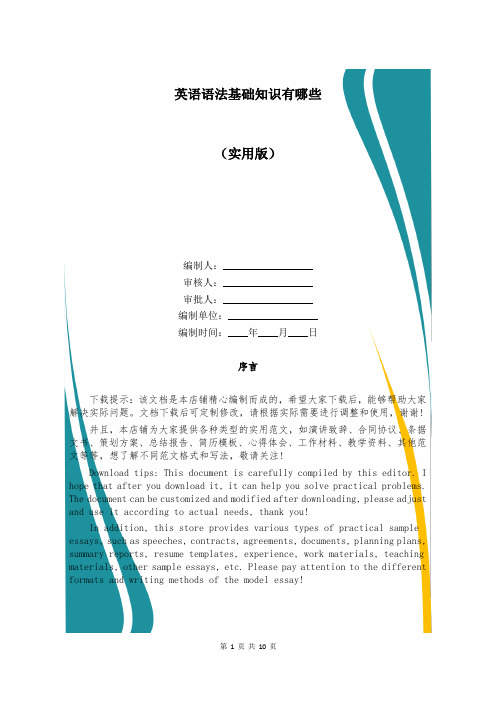
英语语法基础知识有哪些(实用版)编制人:__________________审核人:__________________审批人:__________________编制单位:__________________编制时间:____年____月____日序言下载提示:该文档是本店铺精心编制而成的,希望大家下载后,能够帮助大家解决实际问题。
文档下载后可定制修改,请根据实际需要进行调整和使用,谢谢!并且,本店铺为大家提供各种类型的实用范文,如演讲致辞、合同协议、条据文书、策划方案、总结报告、简历模板、心得体会、工作材料、教学资料、其他范文等等,想了解不同范文格式和写法,敬请关注!Download tips: This document is carefully compiled by this editor. I hope that after you download it, it can help you solve practical problems. The document can be customized and modified after downloading, please adjust and use it according to actual needs, thank you!In addition, this store provides various types of practical sample essays, such as speeches, contracts, agreements, documents, planning plans, summary reports, resume templates, experience, work materials, teaching materials, other sample essays, etc. Please pay attention to the different formats and writing methods of the model essay!英语语法基础知识有哪些英语语法基础知识点有哪些想要学好英语的话,可以尝试去多听英文歌曲,多看英文电影、书籍等。
高中英语语法总结框架
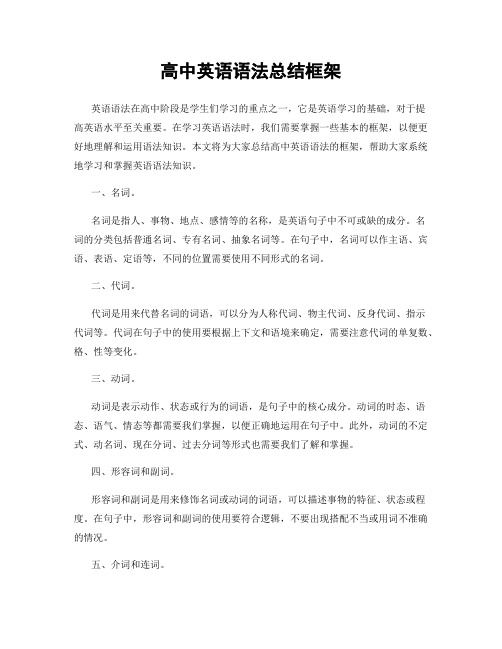
高中英语语法总结框架英语语法在高中阶段是学生们学习的重点之一,它是英语学习的基础,对于提高英语水平至关重要。
在学习英语语法时,我们需要掌握一些基本的框架,以便更好地理解和运用语法知识。
本文将为大家总结高中英语语法的框架,帮助大家系统地学习和掌握英语语法知识。
一、名词。
名词是指人、事物、地点、感情等的名称,是英语句子中不可或缺的成分。
名词的分类包括普通名词、专有名词、抽象名词等。
在句子中,名词可以作主语、宾语、表语、定语等,不同的位置需要使用不同形式的名词。
二、代词。
代词是用来代替名词的词语,可以分为人称代词、物主代词、反身代词、指示代词等。
代词在句子中的使用要根据上下文和语境来确定,需要注意代词的单复数、格、性等变化。
三、动词。
动词是表示动作、状态或行为的词语,是句子中的核心成分。
动词的时态、语态、语气、情态等都需要我们掌握,以便正确地运用在句子中。
此外,动词的不定式、动名词、现在分词、过去分词等形式也需要我们了解和掌握。
四、形容词和副词。
形容词和副词是用来修饰名词或动词的词语,可以描述事物的特征、状态或程度。
在句子中,形容词和副词的使用要符合逻辑,不要出现搭配不当或用词不准确的情况。
五、介词和连词。
介词和连词是用来连接词语或短语的词语,介词主要用来表示位置、方向、时间等,而连词则用来连接并列成分或主从复合句。
在句子中,介词和连词的使用要符合语境,不要出现误用或滥用的情况。
六、句子结构。
句子是语言表达的基本单位,它由主语、谓语、宾语、定语、状语等成分组成。
在学习句子结构时,我们需要了解不同类型的句子,如陈述句、疑问句、祈使句、感叹句等,以及它们的语序和语法规则。
七、语法规则。
除了以上提到的基本语法成分外,我们还需要了解一些常见的语法规则,如倒装句、虚拟语气、主谓一致、定语从句、名词性从句等。
这些语法规则在句子中的运用会影响句子的表达和理解,因此我们需要认真学习和掌握。
总结。
通过以上的总结,我们可以清晰地了解高中英语语法的基本框架,包括名词、代词、动词、形容词和副词、介词和连词、句子结构以及一些常见的语法规则。
英语语法基础知识入门
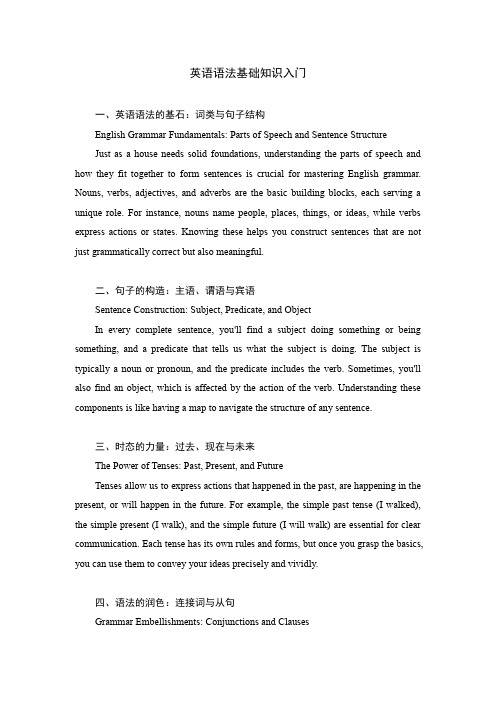
英语语法基础知识入门一、英语语法的基石:词类与句子结构English Grammar Fundamentals: Parts of Speech and Sentence StructureJust as a house needs solid foundations, understanding the parts of speech and how they fit together to form sentences is crucial for mastering English grammar. Nouns, verbs, adjectives, and adverbs are the basic building blocks, each serving a unique role. For instance, nouns name people, places, things, or ideas, while verbs express actions or states. Knowing these helps you construct sentences that are not just grammatically correct but also meaningful.二、句子的构造:主语、谓语与宾语Sentence Construction: Subject, Predicate, and ObjectIn every complete sentence, you'll find a subject doing something or being something, and a predicate that tells us what the subject is doing. The subject is typically a noun or pronoun, and the predicate includes the verb. Sometimes, you'll also find an object, which is affected by the action of the verb. Understanding these components is like having a map to navigate the structure of any sentence.三、时态的力量:过去、现在与未来The Power of Tenses: Past, Present, and FutureTenses allow us to express actions that happened in the past, are happening in the present, or will happen in the future. For example, the simple past tense (I walked), the simple present (I walk), and the simple future (I will walk) are essential for clear communication. Each tense has its own rules and forms, but once you grasp the basics, you can use them to convey your ideas precisely and vividly.四、语法的润色:连接词与从句Grammar Embellishments: Conjunctions and ClausesTo make your writing more sophisticated, you can use conjunctions to connect words, phrases, or clauses, and introduce subordinate clauses to add detail and nuance. For example, "although" can introduce a contrast ("Although it was raining, we went for a walk"), while "because" introduces a reason ("I went for a walk because I needed some fresh air"). Mastering these can make your sentences more complex and interesting.总结:掌握英语语法基础知识,开启语言学习之旅。
英语重要的基础语法知识归纳

英语重要的基础语法知识归纳英语语法知识要点谓语:1、由“不及物动词”、“及物动词+宾语”或“系动词+表语”等构成,说明主语所表示的人物“干什么”或“怎么样”。
如: He travelled in space for the first time.(他首次在太空旅行。
)Who teaches you English this year?(今年谁教你们的英语?)The pizza has gone bad. (那块烤馅饼已经变坏。
) /2、谓语动词必须反映出人称、单复数、时态等信息,谓语动词往往由下列词语依序排列构成:[情态动词]+[时态助动词]+[语态助动词]+[主要动词](不一定全部出现)。
(见动词的时态和语态构成表) 记住:谓语部分第一个动词往往是变形动词。
如:I am sorry I ammaking so much noise but I have to.(对不起我发出了太大的声音但是只能这样。
)Hecan’t havefinishedreading the 800-page-long novel.(他不可能读完了那本长达800页的小说。
)Something mustbedone to stop the fowl flu from spreading out.(该采取措施防止禽流感蔓延。
)(3)谓语动词切忌用“行为动词1”。
3、不可用形容词、名词、代词、副词、介词短语等独立作谓语,必须在此之前加连系动词。
4、谓语动词单复数形式:单数形式的'动词有:is,was,has,does以及“动词+s”;复数形式的动词有:are,were,have以及动词原形。
其他动词不分单、复数。
5、一般问句和反意问句的回答不使用行为动词,应该使用“是”动词、情态动词、助动词(be,will,have,do以及变形)。
如:The Olympic Games is held every other year, isn’t it? ----Yes, it is.(奥运会每两年举办一次,是吗?----是的。
英语基本知识框架图
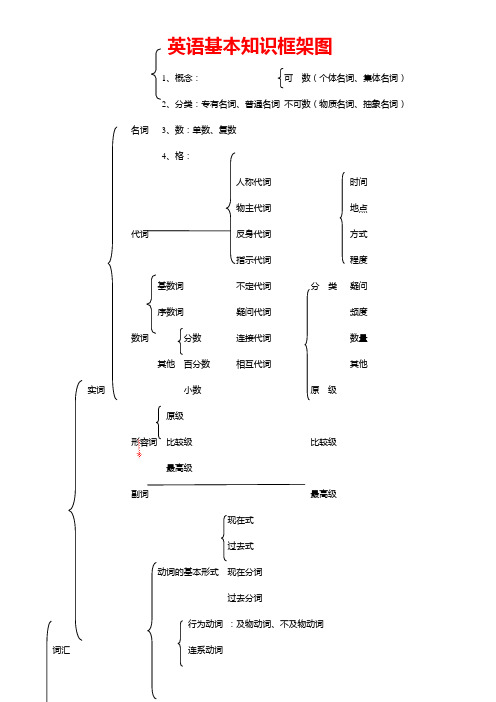
英语基本知识框架图
1、概念:可数(个体名词、集体名词)
2、分类:专有名词、普通名词不可数(物质名词、抽象名词)
名词3、数:单数、复数
4、格:
人称代词时间
物主代词地点
代词反身代词方式
指示代词程度
基数词不定代词分类疑问
序数词疑问代词频度
数词分数连接代词数量
其他百分数相互代词其他实词小数原级
原级
形容词比较级比较级
最高级
副词最高级
现在式
过去式
动词的基本形式现在分词
过去分词
行为动词:及物动词、不及物动词
词汇连系动词
动词分类助动词现在
情态动词
不定式过去
动词的非谓语形式动名词
过去分词主动语态将来
分词现在分词(16种时态)
叹词语态过去将来
连词
虚词被动语态
介词
S+V 时间冠词定冠词S+V+O 地点
不定冠词S+V+P 原因
主要成分:主语、谓语简单句S+V+InO+DO 条件
次要成分:S+V+O+OC 比较、方式句子成分词类和句子成分之间的关系there be 目的
句法陈述句状语从句结果
句子疑问句并列句让步
用途分感叹句
句子种类祈使句定语从句主语从句
表语从句结构分主从复合句宾语从句
名词性从句同位语从句。
(完整版)英语基础知识

英语基础知识一:英语的基本成分有七种:主语、谓语、表语、宾语、定语、状语和补语。
主语:可以作主语的有名词(如boy ),主格代词(如I,she ,he,they,we,you ),指示代词(如this ),动词不定式(如to do sth ),动名词(如doing sth )和主语从句。
The boy is happy. She is friendly. Playing basketball is interesting.To go swimming with him is enjoyable. That he is ill is true. This is wrong.谓语:谓语由动词构成,是英语时态、语态变化的主角,一般在主语之后。
1.不及物动词(vi.)没有宾语,形成主谓结构,如:We come.2.及物动词(vt.)有宾语,形成主谓宾结构,如:They like Englih.3.系动词(系动词一般分两类:be 译为是, look,smell,taste,.feel.touch, keep,stay,seem 等属一类,表示情况;get, grow, become, turn,go,come,fall 等属另一类,表示变化。
)后接表语,构成主系表结构,如:He is happy. The food smells delicious. 宾语: 可以作宾语的有名词(如boy ),宾格代词(如me,her,him,them,us,you ),指示代词(如this ),动词不定式(如to do sth ),动名词(如doing sth )和宾语从句。
I don ’t like the boy. I want to finish the work. I like this.I think that he is happy. I like playing football. You win him.表语: 可以作表语的有名词(如boy ),动词不定式(如to do sth ),动名词(如doing sth ),介词短语(He is in the classroom ),形容词(如good ),方位副词(如The pen is here .)和表语从句。
英语基础知识主谓宾定状补

英语基础知识主谓宾定状补在学习英语的过程中,掌握句子的基本结构——主谓宾定状补,是非常重要的。
这就好比建造房屋,主谓宾是房屋的主体框架,而定状补则是对房屋的装饰和完善。
接下来,让我们逐一了解这些成分。
首先,我们来谈谈主语。
主语通常是句子中执行动作或被描述的对象。
它可以是一个人、一个物、一个概念或者一个短语。
比如说,“The dog is running”(这只狗正在跑。
)在这个句子中,“The dog”(这只狗)就是主语,是进行“跑”这个动作的主体。
再比如,“Love is beautiful”(爱是美好的。
)这里的“Love”(爱)就是主语,是被描述的对象。
接下来是谓语。
谓语往往是表示主语动作或状态的部分。
它通常由动词来充当。
还是以刚才的例子为例,“The dog is running” 中的“is running”就是谓语,描述了狗的动作。
在“Love is beautiful” 中,“is beautiful”则是谓语,表明了“爱”的状态。
宾语则是动作的承受者。
比如,“I eat an apple”(我吃一个苹果。
)“an apple”(一个苹果)就是宾语,是“吃”这个动作的承受对象。
宾语可以是名词、代词、数词等。
定语在句子中起到修饰和限定名词或代词的作用。
它可以是一个形容词、一个短语或者一个从句。
例如,“The beautiful girl is singing”(这个漂亮的女孩在唱歌。
)“beautiful”(漂亮的)就是定语,用来修饰“girl”(女孩)。
再比如,“The book which I bought yesterday is very interesting”(我昨天买的那本书非常有趣。
)“which I bought yesterday”(我昨天买的)这个从句就是定语,修饰“book”(书)。
状语则是用来修饰动词、形容词、副词或者整个句子的成分。
它可以表示时间、地点、原因、方式、程度等。
英语语法基础知识总结
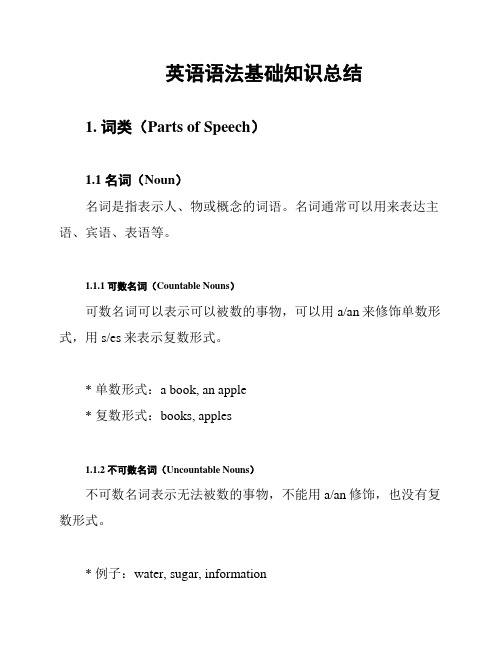
英语语法基础知识总结1. 词类(Parts of Speech)1.1 名词(Noun)名词是指表示人、物或概念的词语。
名词通常可以用来表达主语、宾语、表语等。
1.1.1 可数名词(Countable Nouns)可数名词可以表示可以被数的事物,可以用a/an来修饰单数形式,用s/es来表示复数形式。
* 单数形式:a book, an apple* 复数形式:books, apples1.1.2 不可数名词(Uncountable Nouns)不可数名词表示无法被数的事物,不能用a/an修饰,也没有复数形式。
* 例子:water, sugar, information1.2 动词(Verb)动词用以表示动作或状态。
动词可以分为及物动词和不及物动词。
1.2.1 及物动词(Transitive Verbs)及物动词需要接受一个宾语,来完成其动作的意义。
* 例子:I read a book.(我读一本书。
)1.2.2 不及物动词(Intransitive Verbs)不及物动词不需要接受宾语,它的意义可以独立完成。
* 例子:She sleeps.(她睡觉。
)2. 时态(Tenses)2.1 现在时态(Present Tense)现在时态表示目前正在进行或经常发生的动作。
2.1.1 现在进行时(Present Continuous)现在进行时表示正在进行的动作,使用"am/is/are + 动词-ing"形式构成。
* 例子:I am studying.(我正在研究。
)2.2 过去时态(Past Tense)过去时态表示过去发生的动作。
2.2.1 一般过去时(Simple Past)一般过去时表示在过去某个时间发生的动作,通常用动词的过去式形式表达。
* 例子:She played piano yesterday.(她昨天弹了钢琴。
)2.2.2 过去进行时(Past Continuous)过去进行时表示过去某一时间正在进行的动作,使用"was/were + 动词-ing"形式构成。
英语入门基础知识
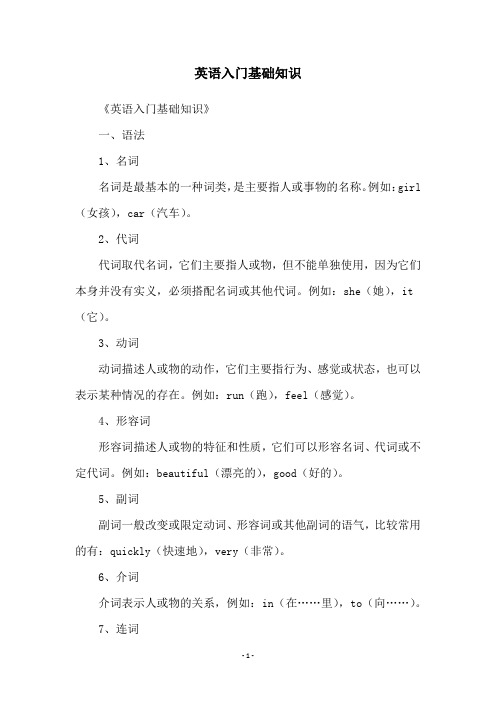
英语入门基础知识《英语入门基础知识》一、语法1、名词名词是最基本的一种词类,是主要指人或事物的名称。
例如:girl (女孩),car(汽车)。
2、代词代词取代名词,它们主要指人或物,但不能单独使用,因为它们本身并没有实义,必须搭配名词或其他代词。
例如:she(她),it (它)。
3、动词动词描述人或物的动作,它们主要指行为、感觉或状态,也可以表示某种情况的存在。
例如:run(跑),feel(感觉)。
4、形容词形容词描述人或物的特征和性质,它们可以形容名词、代词或不定代词。
例如:beautiful(漂亮的),good(好的)。
5、副词副词一般改变或限定动词、形容词或其他副词的语气,比较常用的有:quickly(快速地),very(非常)。
6、介词介词表示人或物的关系,例如:in(在……里),to(向……)。
7、连词连词用来连接句子或句子之间的关系,例如:and(和),but(但)。
8、感叹词感叹词表示对人或事物的好悲喜嫌等态度。
例如:oh(哦),wow (哇)。
二、发音1、元音:A:[ei]比如:cake[keik],name[neim]。
E:[i:]比如:me[mi:],sleep[sli:p]。
I:[ai]比如:nice[nais],time[taim]。
O:[]比如:boat[bt],home[hm]。
U:[ju:]比如:blue[blu:],museum[mju:zim]。
2、辅音:B:[b]比如:book[buk],bed[bed]。
C:[k]比如:cat[kt],clock[klk]。
D:[d]比如:door[d:],dog[dg]。
F:[f]比如:fish[fi],family[fmli]。
G:[g]比如:girl[g:l],green[gri:n]。
H:[h]比如:horse[h:s],happy[hpi]。
J:[d]比如:jump[dmp],jam[dm]。
K:[k]比如:king[ki],kite[kait]。
英语基础知识
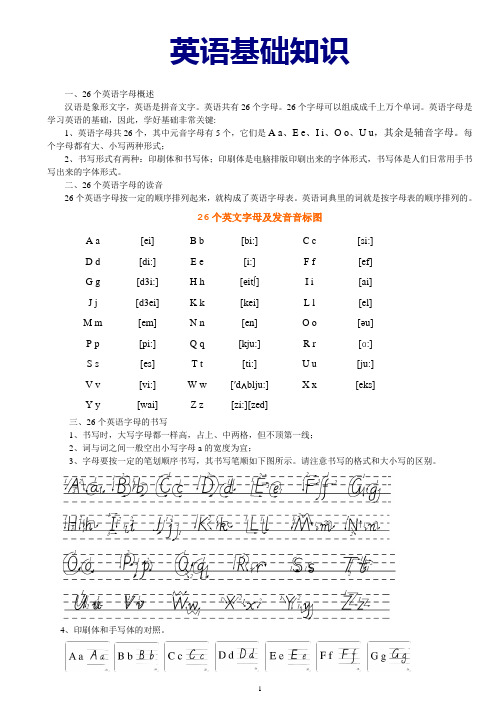
英语基础知识一、26个英语字母概述汉语是象形文字,英语是拼音文字。
英语共有26个字母。
26个字母可以组成成千上万个单词。
英语字母是学习英语的基础,因此,学好基础非常关键:1、英语字母共26个,其中元音字母有5个,它们是A a、E e、I i、O o、U u,其余是辅音字母。
每个字母都有大、小写两种形式;2、书写形式有两种:印刷体和书写体;印刷体是电脑排版印刷出来的字体形式,书写体是人们日常用手书写出来的字体形式。
二、26个英语字母的读音26个英语字母按一定的顺序排列起来,就构成了英语字母表。
英语词典里的词就是按字母表的顺序排列的。
26个英文字母及发音音标图A a [ei]B b [bi:]C c [si:]D d [di:]E e [i:]F f [ef]G g [d3i:] H h [eit∫]I i [ai]J j [d3ei] K k [kei] L l [el]M m [em] N n [en] O o [əu]P p [pi:] Q q [kju:] R r [ɑ:]S s [es] T t [ti:] U u [ju:]V v [vi:] W w [′d∧blju:] X x [eks]Y y [wai] Z z [zi:][zed]三、26个英语字母的书写1、书写时,大写字母都一样高,占上、中两格,但不顶第一线;2、词与词之间一般空出小写字母a的宽度为宜;3、字母要按一定的笔划顺序书写,其书写笔顺如下图所示。
请注意书写的格式和大小写的区别。
4、印刷体和手写体的对照。
四、48个国际音标。
英语国际音标表(48个)元音(20个)辅音(28个)轻辅音: /p/ / t/ / k/ /f/ /θ/ /s/ /ʃ/ / h/ /ts/ /tʃ/ /tr/浊辅音:/b/ /d/ /g/ /v/ /ð/ /z/ /ʒ/ / r/ /dz/ /dʒ/ /dr/鼻音: /m/ /n/ /ŋ/半元音: / j/ / w/边音: / ǀ/Unit 1 Making New FriendsTopic 1 Welcome to China!Section A(1)—Good morning!早上好。
英语基础入门知识

英语基础入门知识
英语基础入门知识包括以下内容:
1. 字母:掌握英文字母的名称、大小写形式和发音,以及字母的顺序。
2. 单词:了解常用的英语单词,包括名词、动词、形容词等,并掌握它们的发音和基本意义。
3. 语法:掌握英语基本的句子结构和语法规则,包括主语、谓语、宾语、定语、状语等基本成分的使用和搭配。
4. 时态:了解英语的基本时态,包括一般现在时、一般过去时、一般将来时等,并掌握它们的基本构成和用法。
5. 句子:学会构建简单句、复合句和复合句,并了解主谓一致、时态一致等基本句法规则。
6. 词组和短语:掌握常用的英语词组和短语,例如问候语、道别语、购物用语等,以便能够进行基本的口语交流。
7. 语法项目:了解一些常见的语法项目,如名词的复数形式、动词的时态和语态变化、形容词和副词的比较级和最高级等。
8. 基本对话:学会以英语进行基本的日常对话,包括问候、自我介绍、询问和回答问题、表达意见等。
9. 阅读理解:通过阅读简单的英语文章,提高阅读理解能力,并能理解文章的大意和主要信息。
10. 写作技巧:掌握一些简单的写作技巧,如写作邮件、日记、短文等,并能够正确使用标点符号和基本的句型结构。
- 1、下载文档前请自行甄别文档内容的完整性,平台不提供额外的编辑、内容补充、找答案等附加服务。
- 2、"仅部分预览"的文档,不可在线预览部分如存在完整性等问题,可反馈申请退款(可完整预览的文档不适用该条件!)。
- 3、如文档侵犯您的权益,请联系客服反馈,我们会尽快为您处理(人工客服工作时间:9:00-18:30)。
英语语法概述一.词类(parts of speech)名词Noun (n.) 表示人或事物的名称冠词Articale (art.) 用在名词前帮助说明名词所指的人或事物代词Pronoun (pron.) 用来代替名词,形容词或数词形容词adjective (adj.) 用来修饰名词,表示人或事物的特征。
数词Numeral (num.) 表示数量或顺序动词Verb (v.) 表示动作或状态副词Adverb (adv) 修饰动词,形容词或其他副词介词Preposition (prep.) 表示名词,代词等和句中其他词的关系连词Conjunction (conj.) 用来连接词与词,短语与短语或句与句感叹词Interjection (interj.) 表示说话时的喜悦,惊讶等情感1.主语主语是一个句子的主体,表示所说的是谁或是什么。
主语一般放在句首,有时在特殊句型中主语放在句末。
可作主语的词有名词,代词,数词,动词不定式,动名词等。
The students are playing volleyball now.Beijing is the capital of China.The shoe shop is next to the supermarket.I go to school by bus every day.Four and five is nine.To read in the sun is bad for your eyes.Getting up early is a good habit.That you forget to tell me the time for the meeting caused me lots of trouble.2.谓语谓语说明主语的动作,行为或所处的状态。
通常由动词的各种形式或动名词短语来充当,并且必须和主语在人称和数上保持一致。
谓语有广义和狭义之分,广义的谓语指主语之外包括动词在内的部分,狭义的谓语仅仅指动词。
She likes drawing.I go to school at 6 on Monday.You should be good with your friends.The skirt felt soft.3.宾语宾语表示动作的对象,是动作的承受者,由名词,代词或相当于名词的词来充当,一般放在及物动词或介词后面。
宾语可分为直接宾语和间接宾语。
We study English.He likes potatoes a lot.I saw her last month.If you put 5 and 7 together, you will get 12.She wants to go to school.They’re helping the poor during the winter.He sent the two injured to the hospital.He enjoys reading.My mother often looks after my little sister on Sunday.She gave me a pen yesterday.4.表语表语和系动词一起构成复合谓语的词或短语。
表语用来说明主语的身份,特征,性质或状态。
名词,代词,数词,形容词,副词,介词短语,分词,动名词,动词不定式和从句都可作表语。
作表语的名词,数词和代词,其数必须与主语保持一致。
Her mother is a teacher.The desk is yours.Tom was the first to come.It sounds good.Seeing is believing.I think my favorite sport is playing tennis.The best way is to say sorry to your mother.He is at home on Sunday.Jim is over there.It is what I like best.5.定语定语是修饰名词或代词的句子成分。
可作定语的有名词,代词,数词,形容词,副词,动词不定式,分词和介词短语等。
形容词,名词作定语时,一般放在名词前,副词,介词短语作定语时,放在名词之后。
There are many apple trees in the village.I like the tall girl.The teacher devided the students into 8 groups.My father goes to work by bus.I want something to eat.He picked up the broken glasses.The girl in a red hat is my younger sister.The man here is Mr. King.The girl who is talking with my mother is my friend.6.状语状语是修饰动词,形容词,副词等的句子成分,说明时间,地点,目的,结果,条件,原因,方式,程度等。
可作状语的有名词,副词,介词短语,不定式短语和从句等。
We go to school every day.We play volleyball on the school playground.I didn’t come on time yesterday because his bike was broken.She didn’t work hard so that she failed in the exam.If it rains tomorrow, we won’t go to the movies.He came to see me.7.宾语补足语宾语补足语用来补充说明宾,与宾语一起构成复合宾语。
可作宾语补足语的有名词,形容词,介词和动词不定式等。
Let me do it.Leave it on the desk.We must keep the classroom clean every day.8.同位语同位语是指用两个或两个以上的词语,指同一个事物,作同一个句子成分。
通常由名词,数词,代词或从句等担当。
She was born in Berkeley , a small town in California.This is Mr Zhou, our English teacher.9.独立成分(1)感叹词There,there! Never mind. It’s nothing serious at all.Oh,no. I never thought it would be so bad.Aha! I’ve got you right here.(2)呼语可置于句首句中或句末。
Ladies and gentlemen, I’ve got an important announcement to make.Hi, everyone! Allow me to introduce myself.Look out, John! There’s a car running over.(3)插入语Nobody knows it, I say, nobody.Who can be fit for the job, do you think?I can’t make it Friday, I’m afraid.1.S+V(1) 不及物动词类在英语中大多数动词既可作及物动词又可作不及物动词,但是下列动词只作不及物动词:apologize, appear, arrive, come, die, disappear, dive, exist, fall, flow, happen, rise等She never lies.The fire happened during the night.(2)及物动词转化来的不及物动词有时主要起及物作用的动词也可用作不及物动词。
常见的此类动词有wash, sell, lock, wear, write, read等。
This new pen writes very smoothly.Poems don’t translat easily.2.S+V+O英语中绝大多数及物动词都是只带一个宾语的动词,常见的有:accept, admire, admit, affect, afford, announce, borrow,bury, celebrate, cover, defeat, defend, destroy, devote, discover, educate, enjoy, equip, explain, forget, guess, invent, love, poat, raise, supply, use等(1)一些动词常用作不及物动词有时又可作单宾语及物动词,但词义往往有所区别。
Farmers in our area grow lots of vegetables.My father runs a big shoe factory.(2)有时宾语后必须加上一个与宾语有关的状语,否则句子就不完整。
You can put the dishes in the kitchen.Tom laid the papers on the desk.3.S+V+P这种句型结构主要指谓语动词为连系动词的情况。
常见的连系动词如下(1)表示状态的连系动词表示状态的连系动词的连系动词常见的有be, look, seem, appear, smell, taste, sound, remain, stay等。
She didn’t appear at all surprised at the news..I can’t stay awake an longer.Her voice sounded strange on the phone.(2)表示转变或结果的连系动词此类动词常见的有become, get, grow, turn, go, come, fall, prove等The weather is becoming warmmer.(强调变化的持续性)They’ve just got married.(强调变化的结构)The milk went sour.(强调性质的变化)All my hair turns grey.(强调颜色的变化)Children grow wiser as they grow older.(表示人或自然的逐步变化)All his dream has come true.(强调情况的改善)4.S+V+Oi+Od这是双宾语的句式结构,可改为“to” 型或“for”型的句式,此类动词常见的有bring, give, hand, offer, pass, pay, post, promise, read, return, sell, send, serve提供, show, teach, tell等She promised me a nice gift on Christmas Day.= She promised a nice gift to me on Christmas Day. Will you please pass the book on the desk to me? = Will you please pass me the book on the desk. 5.S+V+O+Oc(1)形容词作宾补They painted the door red.Keep the children quiet, please.(2)不定式作宾补We have invited all our friends to come.Will you ask Mary to help us?。
